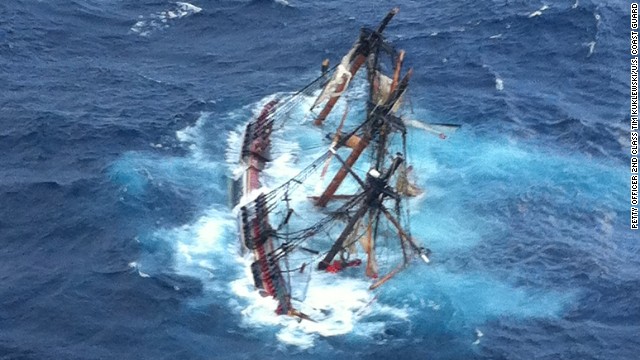 |
| heartbreaking |
In the recent Weather Channel special on the rescue of fourteen of the sixteen crew of the HMS Bounty by the United States Coast Guard, survivor Douglas Faunt said it well: "A wooden boat is always sinking."
The mariners all know, to borrow a turn from Gordon Lightfoot, that there is no permanency to a ship. This was simply a given in the age of sail: The lee shore would come, or simply the timber would give out. The bottom of of any body of water will bear testament to that water's power over the vessels that pass through it. Yet today's tall ships--museums, classrooms, and symbols of the bygone--can achieve such a status that their fragility can be overlooked.
 |
| Wasn't she lovely: HMS Bounty and a nice bow wave |
The 1960 replica of the legendary HMS Bounty has, outside of the family of sailors and fans, perhaps achieved that unfortunate status of becoming more famous in death than in life, like the Edmund Fitzgerald that Gord immortalized in song. The aforementioned TV special places equal emphasis on the tragedy of the ship's loss and the heroism of the Coast Guard. It seemed wise enough for Captain Walbridge, who had commanded the Bounty for seventeen years and through plenty of rough weather, to see riding out Hurricane Sandy at sea as a better alternative to being battered ashore. Whether it was the 80 knot winds and the 30 foot seas, some special circumstance, or some fateful decision that brought the ship and its commander down may never be known. What is clear is that the personnel of an HC-130 and two helicopters braved incredible conditions to rescue the equally courageous souls, in gumby suits and fragile rafts, that made it off the Bounty as she took on water, listed, and sank. USCG rescue swimmers have the most insane job ever, and, really, Daniel Todd deserved a shout out from President Obama. Yet I cannot help but think that for millennia there were no such saviors. Is it possible that sailors take for granted that a Jayhawk will swoop out of the sky, drop a swimmer and a basket, and put the sea at bay?
 |
| Almost beautiful: The La Grace aground |
And is it also possible that we take today's tall ships for granted, as if their curatorial position makes them more invincible than the thousands of real, working vessels that they strive to maintain the memory of? Over at the Fo'c'sle, the fate of the the Czech brig La Grace has been followed after she ran aground at Marbella, Spain, in October. There was no hurricane taking over the national media here, no dramatic rescue. It took weeks for the La Grace to be pulled free, and it is still unclear whether the damage sustained is too severe for the ship to be restored to her previous splendor. Only slightly less alarming was the Fo'c'sle's reporting that schooner W.N. Ragland, built in 1913, the private boat of Neil Young for 35 years, and a regular at the CWB's annual festival (and thus I boat I have been aboard) was dismasted during transit from Seattle to San Francisco.
 |
| La Grace: It could happen to anyone |
You have to be getting the picture by now. All beings are mortal. Boats are mortal. Wooden boats are even more mortal. I shudder at the idea that, some day, dear vessels to me, from the little sharpies Betsy D and Colleen Wagner to the grand ships Lady Washington and Surprise, may not exist. You are the choir being preached to, of course, but recent events MUST REMIND US that we cannot assume that boats we know and love can live and thrive without human care and effort. Let not the deaths of Robin Walbridge, Claudene Christian, and the ship they adored be not without a lesson worth repeating, a purpose worth giving and even sacrificing for. Do everything that you can.
Now.
No comments:
Post a Comment